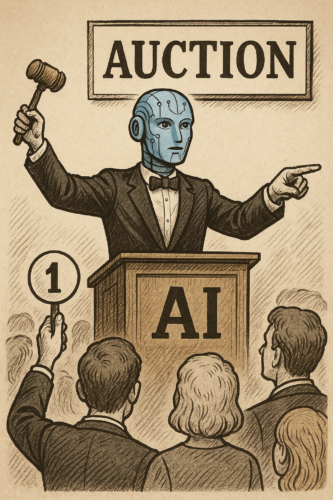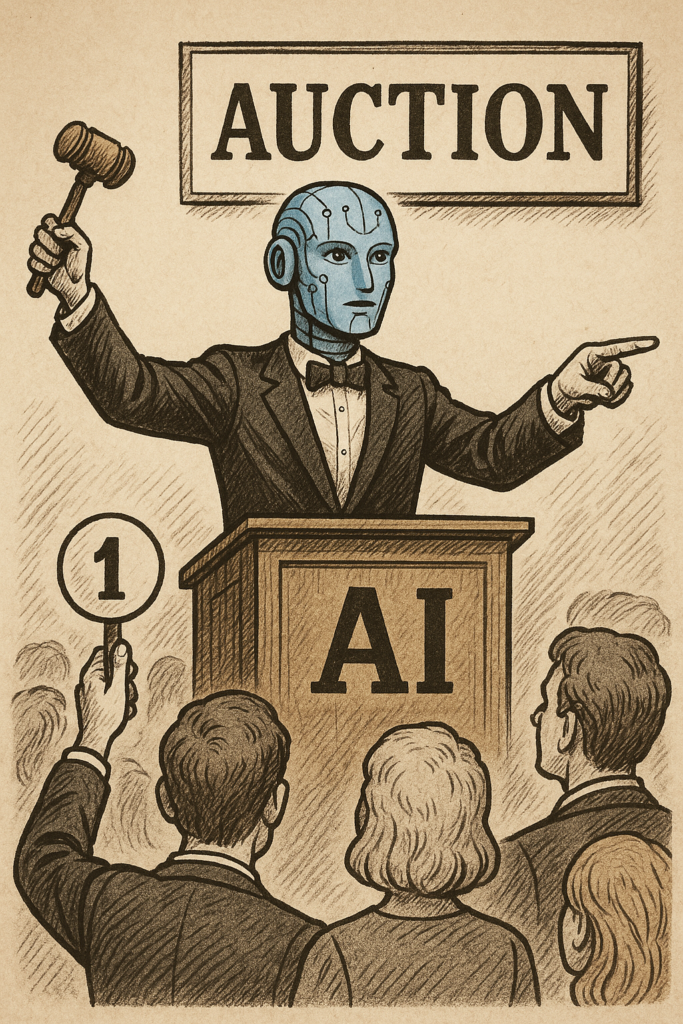The emergence of AI has shifted the paid marketing landscape in several ways – from automated “smart bidding” strategies to dynamically or even automatically created ad content. Advertisers are adopting AI tactics on a broad scale, and for a good reason: machine learning drives stronger performance. Internal Google data shows that over 80% of advertisers have adopted these automated Google Ads strategies, proving how critical AI has become in Paid Search (Whiteshark Media, 2023). Below, we will explore the most exciting real-world applications of AI and challenges to be mindful of.
AI’s Impact on Paid Search: An Overview
When I entered the Paid Search world almost a decade ago, my days were spent manually and painstakingly combing through performance data to apply the proper bid adjustments (anyone else triggered by the idea of a device bid adjustment?) Nowadays, AI has eliminated the need for these manual processes by allowing us to automate tasks with greater efficiency. Specifically, Google Ads smart bidding strategies make these bidding decisions in real time during the auction, with more user data than a typical advertiser would ever have access to, to make sure the right message is served to the right user at the right time. As a result, Google’s smart bidding technology can increase conversions by up to 20%, according to Google.
Because marketers are free from these time-consuming tasks, we can now focus on higher level strategies such as creative. As one industry expert notes, “even modest improvements in automation can significantly reduce workloads and boost results”. One agency reported seeing performance improvements up to 200% by implementing Google’s smart bidding algorithms.

Key AI-Driven Advancements in PPC
AI is revolutionizing several core components of Paid Search campaigns:
- Automated Bidding: Rather than setting manual bids at the keyword level, machine learning has allowed Google Ads to offer extremely sophisticated goal-based strategies that put the focus on the advertiser’s business objectives, as opposed to clicks. Conversion-based bidding such as Maximize Conversions, Target CPA, Maximize Conversion Value, and Target ROAS dynamically set bids in real time based on user signals such as location, demographics, behavior, and more. This targeted method of bidding drives material results for advertisers: advertisers using broad match keywords with Target CPA bidding saw a 35% increase in total conversions (GrowthIQ Digital, 2023). The benefits speak for themselves – more conversions at the same spend means less wasted spend and higher ROI.
- Responsive Search Ads (RSAs): RSAs enable adaptive ad creative on Paid Search by mixing and matching multiple headline and description variations provided by the advertisers. Google’s algorithm will test different combinations of the headlines and descriptions, and serve the ad content most likely to drive results. According to Google, RSAs drive on average a 5-15% higher click-through-rate compared to standard ads (WordStream, 2022). The continual testing RSAs are able to provide and quickly iterate upon would not be possible to replicate manually at scale, and supply advertisers with valuable creative insights.
- AI-Powered Keyword Matching: Advertisers who are familiar with Google’s keyword match types and have been out of the game for a while may feel a shiver down their spines when hearing the term “broad match”. Where exact match and phrase match keywords give marketers some level of control over what queries trigger Search ads, broad match has long been the scary older step-brother of match types, allowing Google much more flexibility over what searches are eligible for ads. However, starting in 2022, Google began to evolve the capabilities of broad match, giving it features that the other match types do not have, such as landing page content and user behaviors. Broad match keywords use all available user signals to make informed bidding decisions in real time, which has been proven to drive more conversions when used alongside smart bidding. And no, you won’t have to spend hours scanning queries for irrelevant keywords – Google’s AI has become increasingly adept at weeding out bad traffic.
- Predictive Analytics and Budget Optimization: Google’s AI and machine learning doesn’t just help advertisers manage performance, it can also help predict it. Historical trends and contextual factors such as seasonality fuel the algorithm so that the bidder is constantly evolving and projecting; even an increase in emerging search queries can feed into the algorithm’s decision-making. Marketing platforms such as Google and Microsoft are also able to push out recommendations to account owners based on trends or predictions such as new keyword recommendations, as well as predictive analytics to forecast spend and conversion scenarios. Budget planning and optimization recommendations are powerful AI tools that marketers can use to stay ahead of the curve, instead of reacting to it.
Improved Performance: Case Studies and Data
Real-world results underscore AI’s payoff in Paid Search:
- Higher Conversion Volume: As mentioned, advertisers can drive material performance improvements by opting into AI features. Using machine-learning products gives Google’s algorithm more flexibility to optimize bids for additional relevant searches. Experian, for example, saw an 18% higher conversion rate and improved return on ad spend after implementing smart bidding, according to a case study (618 Media, 2024).
- Better ROI and Lower Costs: Because the algorithm is so efficient at finding more conversions, AI often improves efficiency of spend. Facebook (Meta) has reported that its automated Advantage+ campaigns yield better cost efficiency – early tests showed 10% lower cost per lead when Advantage+ was enabled for lead generation campaigns (Intero Digital, 2023). These cases show AI can squeeze more results out of each dollar by allocating budget to the highest-value opportunities in real time.
- Time Savings and Scalability: AI’s offers benefits outside of performance marketing as well. Sprout Social, a social media software company, integrated AI into its workflows and reported saving 72 hours per quarter on reporting tasks (worth $16,000 annually) by incorporating automation into its workstreams (Sprout Social, 2025). In the Paid Search world, automating bidding and reporting frees marketers from hours of manual data analysis. This time can be reinvested in strategy and creative improvements, which further boosts ROI. Additionally, the improvements in workflow mean that marketers can manage larger and more complex campaigns without increasing operational costs.
- Fully Automated Campaign Success: Some advertisers have gone so far as to launch fully automated campaigns, completely run by AI. Famously, Harley-Davidson’s NYC dealership used an AI platform called Albert to manage campaigns from start to finish. The results were drastic – the dealership drove a 2,930% increase in sales leads within 3 months, with half of those leads coming from new “lookalike” audiences the AI identified, which wouldn’t have been on the dealership’s radar otherwise. This is, of course, a rare and extreme example – but illustrates that AI, when given broad control over campaigns, can rapidly iterate and find untapped audiences.
Not every AI application will produce such results, and outcomes vary by situation. But at a high level, the industry consistently sees that AI approaches can drive real performance improvements by enhancing processes that were historically done by humans. It’s telling that 71% of marketers using generative AI for content report it performs better than non-AI content (Yahoo!/Publicis Media, 2024) – this positive sentiment extends to the advertising realm as well.

